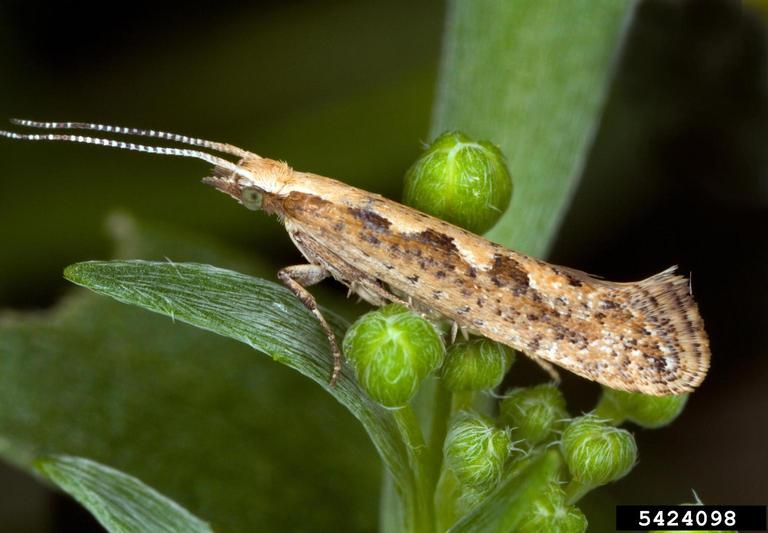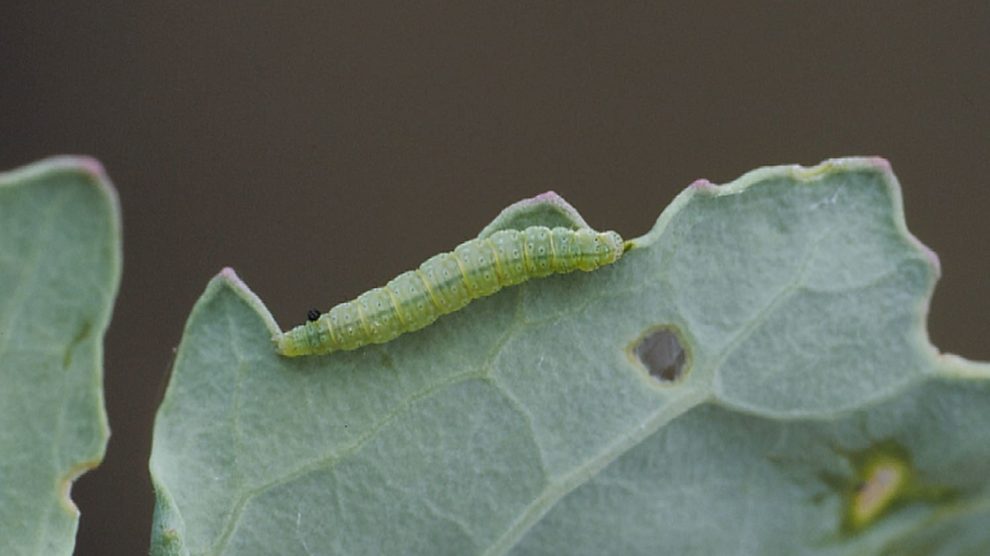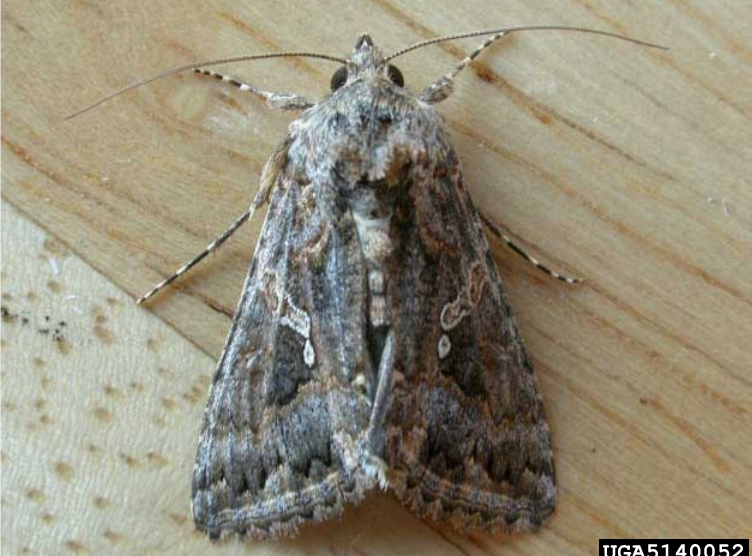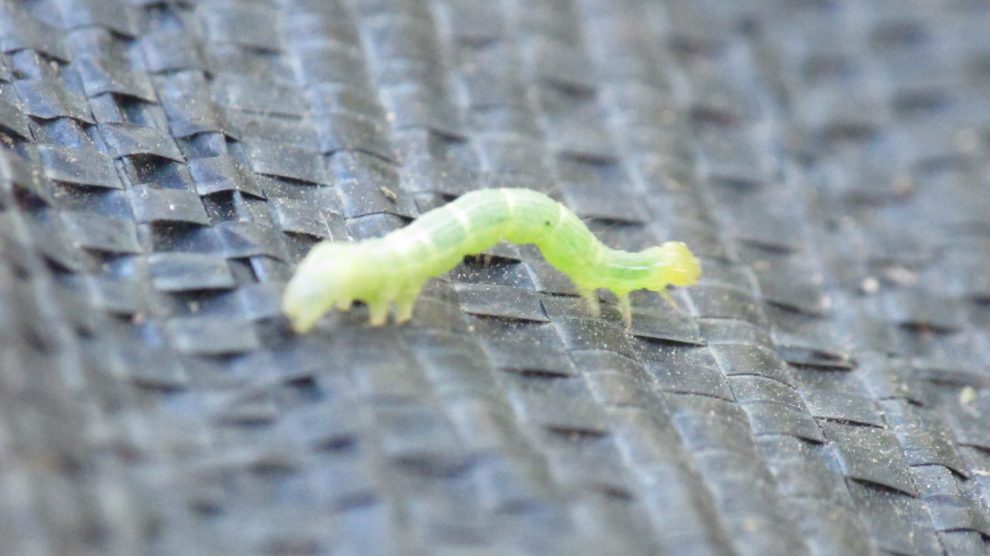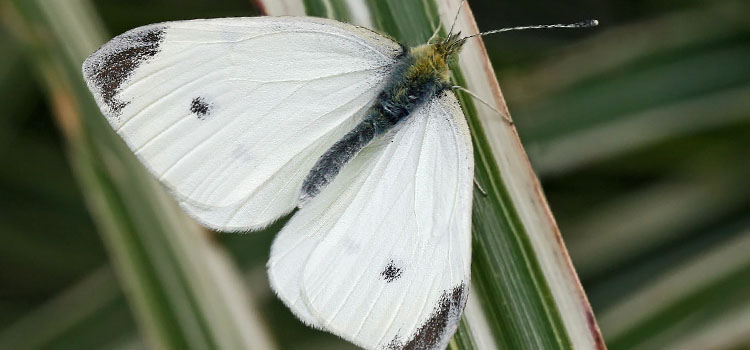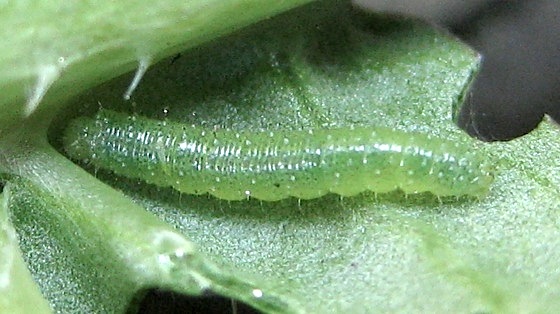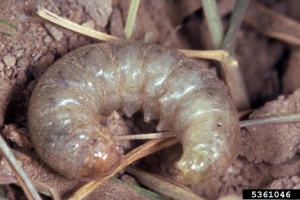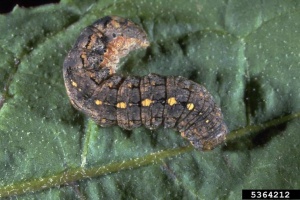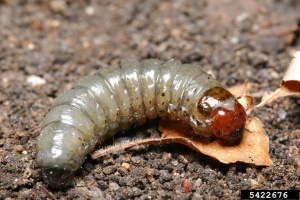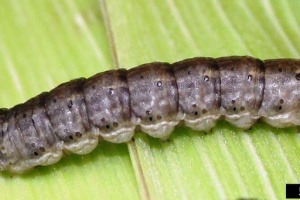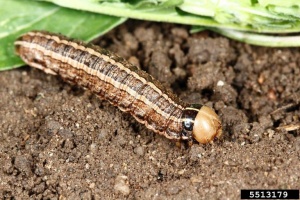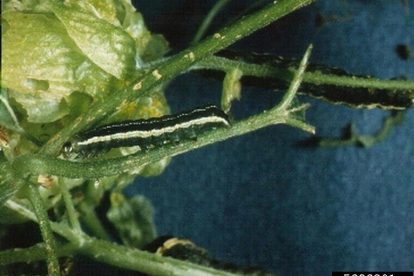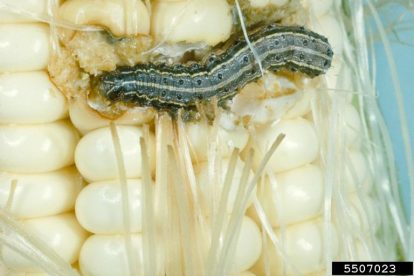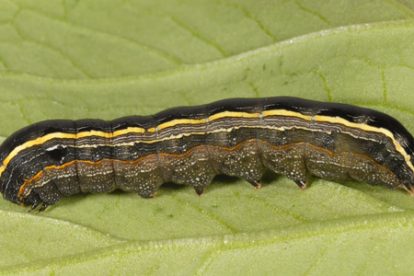In this Issue
- Caterpillar Pests on Various Vegetable Crops
CATERPILLARS
Caterpillar is the term for the larval stage of various moth and butterfly species. Some, of which are currently active and pose a problem for Utah’s vegetable production. These voracious feeders can cause extensive damage to crops, leading to reduced yields and compromised plant health. As they continue to proliferate in the landscape, farmers and gardeners must implement effective monitoring and control strategies to mitigate their impact.
DESCRIPTION AND DAMAGE OF SPECIES
Diamondback moths lay round, yellow eggs approximately 0.4 mm in diameter. The larvae progress through four instars, eventually reaching a length of 1.25 cm and exhibiting a plain green or gray coloration. Pupation occurs within a loose mesh cocoon approximately 1 cm in length. Adult moths are grayish-brown, featuring white or cream-colored diamond patterns and a wingspan of 1.5 cm. The primary host crops are within the Brassicaceae family, including broccoli, Brussels sprouts, cabbage, cauliflower, collards, horseradish, kale, kohlrabi, radish, and turnips. Additionally, numerous weed species within the Brassicaceae family also serve as hosts. Larvae cause damage by chewing holes in leaves, leading to significant defoliation. Initial feeding occurs on the outer leaves, but as the larvae mature, their feeding intensifies, and they often penetrate the developing heads, creating tunnels. This feeding activity can result in contamination from frass (fecal material), thereby reducing the quality of the produce.
Watch our video on diamondback moth identification and management.
Cabbage looper eggs are dome-shaped and light yellow. The larvae develop through five instars, characterized by a smooth texture and a color range from pale to dark green. They are slender with white or light-yellow stripes and have a tapered head. The pupation occurs within a fuzzy cocoon measuring approximately 3 cm. Adult moths are grayish-brown with distinctive silver markings and have a wingspan of 4 cm. Host plants primarily belong to the Brassicaceae family, including broccoli, Brussels sprouts, cabbage, cauliflower, collards, horseradish, kale, kohlrabi, radish, and turnips. Numerous weed species within this family also serve as hosts. The larvae feed by chewing holes in leaves, which can lead to significant defoliation. Initially, feeding occurs on the outer leaves, but as the larvae mature, their feeding activity intensifies, often moving into the developing heads and creating tunnels. This can result in frass (fecal material) contaminating the leaves, thereby reducing the quality of the produce.
Watch our video on cabbage looper identification and management.
Imported cabbageworm adult butterflies lay bullet-shaped eggs that are approximately 1 mm long. The larvae develop through five instars, growing up to 4 cm in length. They are green with thick yellow stripes, featuring blunt ends and dense short hairs. The pupae, or chrysalides, are 2 cm long and display yellow, gray, and green coloration with a sharply angled, keel-like projection dorsally on the thorax. Adult butterflies are white, with females having two dark spots and males having one dark spot on their wings. The adults have a wingspan of 5 cm. Host plants primarily belong to the Brassicaceae family, including broccoli, Brussels sprouts, cabbage, cauliflower, collards, horseradish, kale, kohlrabi, radish, and turnips. Many weed species within this family also serve as hosts. Larvae feed by chewing holes in leaves, causing significant defoliation. Initial feeding occurs on the outer leaves, but as the caterpillars mature, their feeding intensifies, and they often penetrate the developing heads, creating tunnels. This activity can result in frass (fecal material) contaminating the leaves, thereby reducing the quality of the produce.
Watch our video on imported cabbageworm identification and management.
Cutworm larvae range in color from dull gray to brown and are notable for curling into a “C” shape when disturbed. Adult moths exhibit a variety of patterns and range in color from brown to gray, with a wingspan reaching up to 1.5 inches. Common cutworm species found in Utah include the army cutworm (Euxoa auxiliaris), black cutworm (Agrotis ipsilon), glossy cutworm (Apamea devastator), pale western cutworm (Agrotis orthogonia), and variegated cutworm (Peridroma saucia). Cutworms are known to feed on nearly all vegetables, as well as alfalfa, grains, and turf grasses. They also have alternate weed hosts such as curly dock, lambsquarters, and pigweed. The name “cutworm” comes from their behavior of “clipping off” young seedlings at the soil surface with their chewing mouthparts. Later in the season, they may also cause damage to fruit and foliage.
Armyworm moths are typically mottled gray and brown with light-colored markings, and their wingspans range from 25 to 40 mm. The larvae display a wide range of colors, from tan to green to almost black. Common species of armyworms include the beet armyworm (Spodoptera exigua), bertha armyworm (Mamestra configurata), fall armyworm (Spodoptera frugiperda), and western yellow-striped armyworm (Spodoptera praefica). Armyworms feed on a variety of host crops such as alfalfa, asparagus, beans, beets, Brassicas, leafy greens, cucurbits, peppers, potatoes, tomatoes, and many other vegetables. They also infest grassy weeds and various herbaceous ornamentals as alternate hosts. The larvae have chewing mouthparts, which cause irregular holes, shredded leaves, or skeletonized foliage. Additionally, armyworms may bore into the heads of leafy vegetables or chew on stems, flower buds, and upper plant roots.
MONITORING
Monitoring for caterpillar pests is crucial, especially early in the season. Regularly inspect a selection of plants for feeding damage on newer foliage. Shake a portion of the plant over a tray (paper or cardboard) to dislodge any larvae. Additionally, scout plantings for eggs and larvae on the undersides of leaves, particularly the innermost leaves. Feeding damage and excrement are also indicators of an infestation. When scouting, examine at least 10% of a specific crop and check representative parts of your garden or farm. Look for adult moths or butterflies as well. For example, adult imported cabbageworms (white butterflies) are commonly seen flying among plants during the day. Sticky traps are an effective way to identify when adult moths or butterflies have arrived in an area and can indicate their relative numbers. If you find injured plants, dig about 1 inch deep around the base of the plants to check for live cutworms.
MANAGEMENT
- For gardeners with small spaces, handpicking and destroying larvae during monitoring can be effective.
- Apply row covers (e.g., spunbond or mesh netting) over plants to prevent adult moths or butterflies from laying eggs.
- Plant early or use early-maturing varieties. Older, mature plants can better tolerate caterpillar feeding damage than young seedlings.
- Remove excess plant debris from the farm or garden site at the end of the growing season, as it may serve as an overwintering site for various caterpillar stages.
- Grow vegetable varieties that are tolerant to specific caterpillars. For example, some mustards, turnips, and kohlrabi are more tolerant to diamondback moths. Glossy-green Brassica varieties that lack the normal waxy, grayish-green bloom are somewhat resistant, as larvae spend more time searching and less time feeding on the glossy leaves.
- Tilling, discing, or turning the soil in spring or fall can disrupt and destroy overwintering pupae (or other life stages) and reduce their population for the following season.
- Weeds growing within or near the farm or garden site can provide alternate food sources for caterpillar pests. Removing cool-season weeds can help starve young caterpillars. Lambsquarters and wild mustards are particularly attractive plants for egg-laying.
- Beneficial insects play a major role in natural biological control. Lady beetles and green lacewings prey on eggs. Paper wasps (Vespidae) will feed on many small caterpillars, including early instar hornworm larvae. General predators such as shield bugs, ambush bugs, and vespid wasps also attack caterpillars, as do many birds. Additionally, several species of small parasitic wasps target specific host caterpillars.
- Bacillus thuringiensis (Bt) is a popular and effective microbial insecticide that targets caterpillars. It acts as a stomach poison that must be ingested by the caterpillar and works best when caterpillars are young and actively feeding. Bt has a short residual effect and is non-toxic to mammals, beneficial parasitoids, and predators. Most Bt formulations meet organic certification standards.
- There are several insecticide products available, containing both organic and synthetic active ingredients, for small-scale and commercial use. When selecting products, review the label to ensure your targeted caterpillar species is listed, along with allowed use on the intended crop.
Do you use high tunnels on your farm? Check out our fact sheet on specifically managing caterpillar pests in high tunnels.

